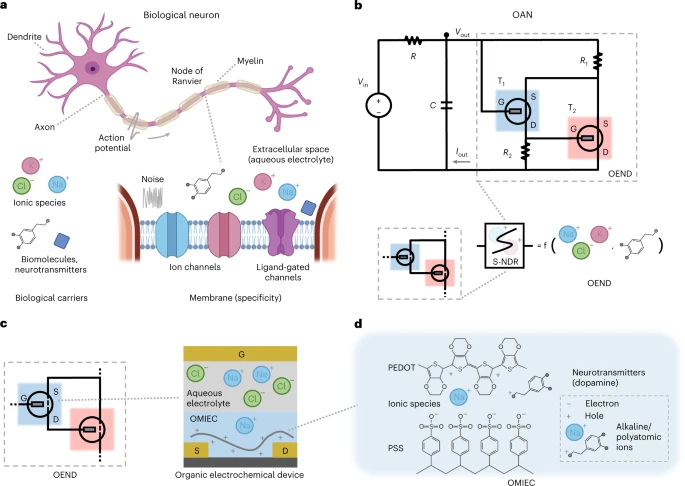
Artificial organic neurons facilitate the connection between biology and electronics.
Scientists have developed the first bio-realistic artificial neuron that can effectively interact with real biological neurons.

The development of artificial intelligence has been going on for a long time, but it remains a hot topic today. A computer algorithm "learns" from examples and determines its correct and incorrect responses. In contrast to a computer algorithm, the human brain works with neurons - brain cells. They learn and transmit signals to other neurons. This complex network of neurons, pathways, and synapses controls our thoughts and actions.
Biological signals are much more diverse than ordinary computer signals. Neurons in a biological neural network interact with the biochemical environment. Specifically, neurons "communicate" either chemically, by releasing messenger substances, or with the help of electrical impulses.
The effective operation of artificial neurons is the key to the development of neuromorphic electronics. Artificial neurons must realistically simulate the function of their biological counterparts and process the full range of signals that exist in biology.
At the moment, the biggest problem is the inability of such neurons to work in a biological environment, which significantly limits their capabilities. Many variations of artificial organic neurons have been created based on conventional circuit generators. They electrically emulate their biological counterparts, but do not take into account the humid biological environment, which consists of ions, biomolecules, and neurotransmitters.
Scientists led by Paschalis Gkoupidenis, head of the group in Paul Blom's department at the Max Planck Institute for Polymer Research, have solved this problem and developed the first bio-realistic artificial neuron based on a compact nonlinear electrochemical element. The artificial neuron can work in a liquid and is sensitive to the concentration of biological substances (such as dopamine or ions) in its environment. It can generate different pulse dynamics that exist in biology. As a result, such artificial neurons will be able to "communicate" with their real biological counterparts.
According to the Gkoupidenis, such an artificial element can become the key to bio-realistic neuroprostheses that will communicate in the same language as biology, allowing to effectively restore, replace or even enhance the functions of the nervous system.
An Organic Artificial Neuron (OAN) is created from a compact nonlinear element consisting of only two Organic Electrochemical Transistors (OECTs). They operate in an aqueous environment and are sensitive to ionic particles and polyatomic ions. OAN demonstrates key characteristics observed in the peak response of biological neurons. OAN operates in a liquid, and this property resembles the extracellular environment of biological neurons in cerebrospinal fluid. The excitability of OAN, i.e. the neuron's tendency to fire spikes, can be modulated by the presence of electrochemical oscillations transmitted by the flow of ions in the electrolytic environment. The electrochemical oscillations of the liquid form the activation properties of OAN, mimicking the characteristic features of biological neurons. As already mentioned, OAN is designed based on a nonlinear electrochemical element. Like biological neurons that function in a humid environment, OAN can imitate biological sensitivity to ionic and biomolecular particles in the surrounding aqueous environment. The artificial neuron demonstrates nonlinear phenomena that depend on the composition of the biophysically significant host environment. Scientists have experimentally confirmed its operation with different electrolytes, including common aqueous electrolytes, buffer solutions, and cell culture media. They have also created biohybrid interfaces in which OAN was modulated by the biological membrane of epithelial cells in real time.
As a result, scientists managed to create an artificial neuron that behaves realistically and is able to communicate in biological environments in different ways, including chemically or through ion charge carriers.
Read the published research paper here.
